For over 50 years—from July 1, 1875 to October 1, 1925—the United States maintained a two-cent UPU post and postal card rate. The rate spanned the Golden Age of postcards in the early 1900s. According to United States government records for the fiscal year ending
June 30, 1908, 677,777,798 postcards were sent that year when the country’s population was only 88,700,000.
The first United States postal card (i.e., a card with a stamp imprint)—a one-cent card for domestic use—was issued in May 1873 [Scott UX1]. It was not until an Act of Congress took effect on May 19, 1898, that private printers were permitted to print and sell postcards. However, they had to be called "Private Mailing Cards" rather than postcards. This law changed on December 4, 1901, when private printers were finally permitted to use the word postcard (or post card) instead of Private Mailing Card on their cards.
Prior to World War I, most postcards were printed in Germany where lithography was more advanced than in the United States. After World War I, the quality of cards dramatically declined as the German lithography industry was not reconstructed. Consequently, during the post-war period from 1915 to 1930, many postcards were printed in the United States. They often show a white border around the view. This was done to save on ink during a period of costly labor and intense competition in which many postcard manufacturers went out of business.
Shown below chronologically are some examples posted to Luxembourg.
 Example 1—1884 [Sc UX6]: The first United States postal card for international use—a two-cent blue Liberty head, which was issued on December 1, 1879—used from New York City, New York, May 13, 1884 to Wiltz, Luxembourg (erroneously addressed to non-existent Wiltz, Germany!) but properly received at Luxembourg-Gare, May 25, 1884. A lengthy privately printed advertisement by the Liebman & Butler Company appears on the back.
Example 1—1884 [Sc UX6]: The first United States postal card for international use—a two-cent blue Liberty head, which was issued on December 1, 1879—used from New York City, New York, May 13, 1884 to Wiltz, Luxembourg (erroneously addressed to non-existent Wiltz, Germany!) but properly received at Luxembourg-Gare, May 25, 1884. A lengthy privately printed advertisement by the Liebman & Butler Company appears on the back.
 Example 2—1884 [Sc UX7]: Domestic postal card issued in 1881, uprated with a one-cent Franklin definitive [Sc 206], and sent from New York City, August 27, 1884, transiting at London [on the back], September 6th, and received at Luxembourg-Ville, September 8, 1884. The rubber stamped message reads:
Example 2—1884 [Sc UX7]: Domestic postal card issued in 1881, uprated with a one-cent Franklin definitive [Sc 206], and sent from New York City, August 27, 1884, transiting at London [on the back], September 6th, and received at Luxembourg-Ville, September 8, 1884. The rubber stamped message reads:
Dear Sir,
Please take notice that our Circular Notes No. 716 and 717 for £ 10 each have been lost or stolen.
Yours respectfully,
C.B. Richard & Co.
[Bankers and General Passenger Agents, Hamburg Steamship Line]

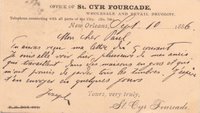
Example 3—1886 [Sc UX6]: New Orleans, Louisiana, September 10, 1886, properly addressed to Wiltz, Luxembourg, received there September 24, 1886. The message side features a printed heading for the Office of St. Cyr Fourcade, Wholesale and Retail Druggist.
 Example 4—1888 [Sc UX6]: Lacking a departure postmark but written at Dubuque, Iowa, August 20, 1888, and showing a Luxembourg-Gare transit and Larochette [Fels] receiver, September 3, 1888.
Example 4—1888 [Sc UX6]: Lacking a departure postmark but written at Dubuque, Iowa, August 20, 1888, and showing a Luxembourg-Gare transit and Larochette [Fels] receiver, September 3, 1888.
Example 5—1894 [Sc UX12]: Cold Spring, Minnesota, March 30, 1894, received at Remich, April 12, 1894, uprated with a one-cent Columbian Exposition commemorative [Sc 230] to pay the UPU postal card rate.
Example 6 - 1895 [Sc UX12]: Sayreville, New Jersey, June 10, 1895, transit New York City, June 10th, received Luxembourg-Ville, June 21, 1895, uprated with a one-cent blue Franklin definitive [Sc 264].

Example 7—1896 [Sc UX6]: Personal correspondence from a writer in Dubuque, Iowa, August 22, 1896, to the priest at Harlange [Harlingen] near Wiltz.
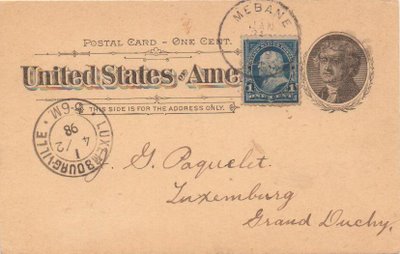 Example 8—1898 [Sc UX12]: Domestic postal card issued in 1894 uprated with a one-cent blue Franklin definitive [Sc 264] and sent from Mebane, North Carolina, January 23, 1898, to a well-known stamp dealer in Luxembourg-Ville, received February 4, 1898.
Example 8—1898 [Sc UX12]: Domestic postal card issued in 1894 uprated with a one-cent blue Franklin definitive [Sc 264] and sent from Mebane, North Carolina, January 23, 1898, to a well-known stamp dealer in Luxembourg-Ville, received February 4, 1898.
Example 9—1901: Private mailing card with a two-cent Washington definitive positioned within a stamp collar, posted from Asbury Park, New Jersey, August 17, 1901, to Brussels, Belgium, received August 29th, forwarded to Hotel Ensch, Vianden, Luxembourg, received August 30th. The view side shows Sunset Lake, Asbury Park, New Jersey.

Example 10—1902 [Sc UX16]: Liberty head postal card issued in 1897 and sent from New York City, New York, May 5, 1902 [machine cancel], to Cap [Capellen], received May 13, 1902.
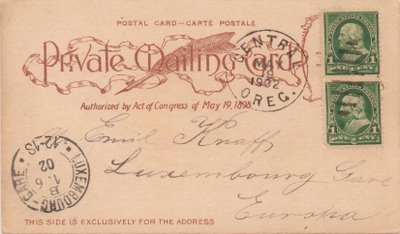
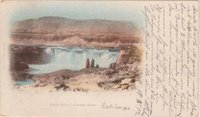 Example 11—1902: Private Mailing Card (a PMC) published by Edward H. Mitchell, showing a view of Celilo Falls on the Columbia River in Oregon, and posted from Central, Oregon, May 19, 1902, to Luxembourg-Gare, June 1, 1902, franked with a pair of the one-cent green Franklin definitive [Sc 279]. Central's post office only operated from 1900 to 1903.
Example 11—1902: Private Mailing Card (a PMC) published by Edward H. Mitchell, showing a view of Celilo Falls on the Columbia River in Oregon, and posted from Central, Oregon, May 19, 1902, to Luxembourg-Gare, June 1, 1902, franked with a pair of the one-cent green Franklin definitive [Sc 279]. Central's post office only operated from 1900 to 1903.
Example 12—1904: Beginning in December 1901, privately printed cards were permitted with the caption "Post Card" instead of "Private Mailing Card." Here two one-cent Livingston Louisiana Purchase commemoratives [Sc 323] frank a postcard posted from New Orleans, Louisiana, September 7, 1904, to Luxembourg-Gare. The viewside shows "#6832 - Train loads of cotton for export."
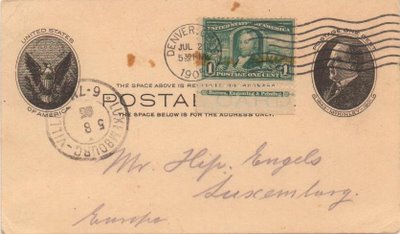 Example 13—1905 [Sc UX18]: Domestic postal card issued in 1902, uprated with a one-cent Livingston Louisiana Purchase commemorative [Sc 323], sent from Denver, Colorado, July 21, 1905, received at Luxembourg-Ville, August 5, 1905.
Example 13—1905 [Sc UX18]: Domestic postal card issued in 1902, uprated with a one-cent Livingston Louisiana Purchase commemorative [Sc 323], sent from Denver, Colorado, July 21, 1905, received at Luxembourg-Ville, August 5, 1905.

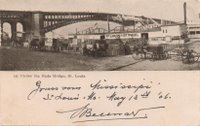 Example 14—1906: Undivided back postcard posted on May 13, 1906, from St. Louis, Missouri, shortly before the undivided back era ended, addressed to a Monsieur Bellwald (perhaps the prominent Luxembourg photographer and editor of postcards, J-M Bellwald, (1871-1945)) posted from Larochette, May 23, 1906, showing a view of the Eads Bridge across the Mississippi River at St. Louis (built from 1867-1874) and a steamship on the river
Example 14—1906: Undivided back postcard posted on May 13, 1906, from St. Louis, Missouri, shortly before the undivided back era ended, addressed to a Monsieur Bellwald (perhaps the prominent Luxembourg photographer and editor of postcards, J-M Bellwald, (1871-1945)) posted from Larochette, May 23, 1906, showing a view of the Eads Bridge across the Mississippi River at St. Louis (built from 1867-1874) and a steamship on the river
 Example 15—1906 [Sc UX18]: Domestic postal card issued in 1902, uprated with a one-cent Franklin definitive [Sc 300], sent from
Example 15—1906 [Sc UX18]: Domestic postal card issued in 1902, uprated with a one-cent Franklin definitive [Sc 300], sent from
St. Paul, Minnesota, July 13, 1906, to the Luxembourg Prison chaplain, received at Luxembourg-Ville, July 24, 1906.

 Example 16—1908: Divided back postcard printed in Germany showing a view of Dawson in the Canadian Yukon Territory, posted from Everett, Washington [flag cancel], June 3, 1908, to Dudelange, franked with a two-cent Washington definitive [Sc 319].
Example 16—1908: Divided back postcard printed in Germany showing a view of Dawson in the Canadian Yukon Territory, posted from Everett, Washington [flag cancel], June 3, 1908, to Dudelange, franked with a two-cent Washington definitive [Sc 319].
Example 17 - 1909: Divided back postcard showing the oldest house in Patchogue, Long Island, New York, posted from Patchogue, August 19, 1909, to Vianden, received August 30, 1909 cds, franked with a two-cent red Washington definitive.

 Example 18—1910: Divided back postcard showing a view of the California state Capitol, Sacramento, California, posted from Chicago, Illinois, February 19, 1910, to Eschweiler, received at Wiltz, March 5, 1910, franked with a two-cent Seward Alaska-Yukon-Pacific Exposition Issue commemorative [Sc 370].
Example 18—1910: Divided back postcard showing a view of the California state Capitol, Sacramento, California, posted from Chicago, Illinois, February 19, 1910, to Eschweiler, received at Wiltz, March 5, 1910, franked with a two-cent Seward Alaska-Yukon-Pacific Exposition Issue commemorative [Sc 370].
Example 19—1910 [Sc UX19]: One-cent McKinley postal card uprated with a one-cent Franklin definitive, posted from Times Square Station, New York City, March 31, 1910, to 'Luxemberg' with a mimeographed back acknowledging receipt of the proof of an article for the Catholic Encyclopedia.
Example 20—1937: Real photo postcard of riders descending on horses down into the Grand Canyon posted from Grand Canyon, Arizona, June 2, 1937, to Poste Restante, Luxembourg-Ville, June 14, 1937, forwarded to Stockholm, Sweden, franked with a three-cent Gilbert Stuart Washington definitive [Sc 720].
to Stockholm, Sweden, franked with a three-cent Gilbert Stuart Washington definitive [Sc 720]. Ah … the two-cent postcard era had ended on October 1, 25!
Ah … the two-cent postcard era had ended on October 1, 25!
But ... you could still send a postcard without a message at the
one-cent UPU printed matter rate until April 1, 1932, as shown in the example below.
Example 20—1930: Picture postcard showing the bridge between Davenport, Iowa and Rock Island, Illinois, properly franked with a one-cent Franklin definitive (on the view side) tied by the Davenport handcancel, July 18, 1930, addressed to Esch-sur-Alzette, Luxembourg. On the address side is the Davenport machine cancel of the same date and the auxiliary mark "Held for Postage," which has been crossed out, presumably after the mail clerk noticed that postage had been affixed to the view side. In manuscript is the endorsement "Printed Matter Europe" (and "over," signaling the clerk to search for the postage on the view side)!














1 comment:
Hello,
I would be interested in the St Louis card sent to Bellwald.
This might have been sent by auguste Bellwald to his brother Jacques Marie or his father Nicolas. I know Auguste was a Marist father and Bishop in the USA. If Possible, could I have a both side scan. I am studying my family for several years now.
my email if interested:
claudel.lamesch@tele2.lu
Best regards
Claude
Post a Comment